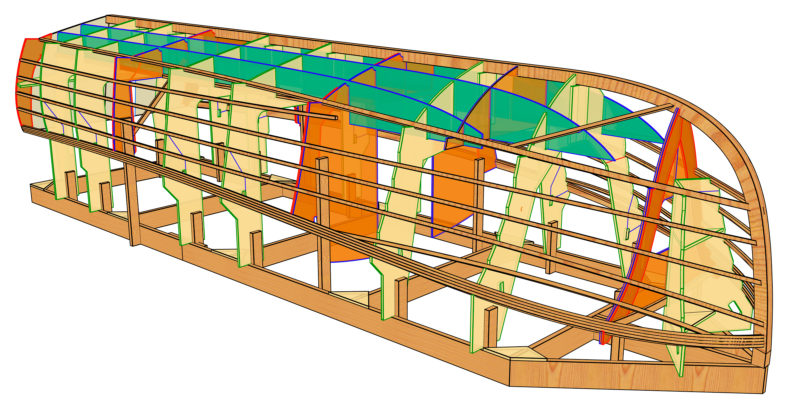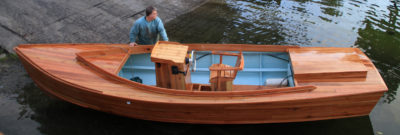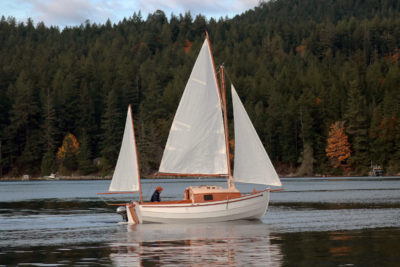I have been obsessed with sailing and building boats for most of my life, but my wife, Luanne, told me when we met that she gets seasick on boats. Lucky for me, she became an accomplished kayaker and a competent co-captain aboard our Outer Banks 26, ROSIE. Living on Salt Spring Island in British Columbia, we are surrounded by water and going anywhere off the island means either a kayak or a ferry. Working around ferry schedules gets tiresome and while a sailboat would be lovely, I had noticed that most of the sailboats in our area travel under power. When Luanne suggested we get a small power skiff to get around more fluidly, it was the first time I seriously considered having a powerboat. It would have to be fuel-efficient and aesthetically appealing, which, to my mind, means traditional lines.
I went online and started searching for a suitable power skiff to build. One of the first boats that came up on my search was a gorgeous 20′ lobsterboat-inspired design by Graham Byrnes of B&B Yacht Designs. It immediately checked the boxes of beautiful and traditional. I found that Graham was known not only for his eye-pleasing boats of all kinds, but also for innovation in design. In 2009, he won a WoodenBoat magazine design competition for a fuel-efficient 18′ powerboat. I was intrigued by Graham’s work and sent for his Outer Banks 20 study plans. After much discussion, Luanne and I decided something a bit larger would be better for multi-week trips. While Graham also had an Outer Banks 24, a slightly stretched version sounded perfect. I asked him about lengthening the 24, and a few weeks later he had designed the Outer Banks 26 from the keel up. I was smitten by the drawings and ordered the plans.
 Photographs by and courtesy of the author
Photographs by and courtesy of the authorThe egg-crate construction gives the hull strength without a lot of weight.
The Outer Banks 26 shares many features with the smaller B&B Outer Banks designs with their Carolina-style bows, which look good and help keep water off the deck in a chop. The stern has a nicely curved transom and sweet tumblehome. Graham selected a modest monohedron deadrise of 12 degrees to provide a good balance between a smooth ride and modest fuel consumption. As I pored over the drawings in the plans, the artistry that Graham blends with his technical skills became more apparent: subtle changes in the size of the oval ports to match the proportional changes in the trunk cabin height and a pleasing arch in the pilothouse door are good examples. Some of these features add to the complexity of the build, but the end result is worth it.
I was pleased to see that Graham had specified a 90-hp outboard as the main power source. Compared to most other boats of this size, that is a small power plant. A few of my boating friends shook their heads at the meager outboard that was expected to push a boat of this size on plane. With a designed displacement of 3,360 lbs, the Outer Banks 26 is relatively lightweight, and I could only hope they were wrong. Here are a few words from Graham to explain some of his design philosophy for powerboats of this type:
With a small motor you need less fuel, and with a light hull you can still get a comfortable interior and meet our target speed. Our design interest was to avoid the greed for speed and aim for the best economy accepting a decent cruising speed. I like to make around 20 knots at about 75 percent full power. This should allow you to run fairly flat at about 3 degrees trim and is quieter while not flogging the engine and having another 25 percent reserve power if you need it. A dead-flat bottom is the most efficient planing shape, but it is not very seaworthy or comfortable. I find that with 12 degrees deadrise aft I can keep the twist out of the planing area and get a pretty fine entry angle for minimal pounding in a head sea. The pounding loads between 30 and 45 knots are huge. I design the structure for 30 knots plus a safety factor using egg-crate construction, and follow aircraft techniques. The topsides are more Maine than Outer Banks, with her fairly plumb bow with generous flare blending to tumblehome aft. This shape cannot be achieved in folded ply, but if you care about aesthetics, it is worth the extra work. It also gives the builder better accuracy and control of the shape.
The plans specify okoume plywood for planking and bulkheads, yellow cedar for stringers, and fiberglass and epoxy for sheathing and fillets. The bottom is 12mm in thickness and joins with the egg-crate structure to provide a strong hull. The topsides are planked using the Ashcroft method with two, diagonally overlapping, and staggered layers of 4mm okoume plywood. The exterior and bilge are sheathed with fiberglass and epoxy. Everything has three coats of epoxy to seal the wood.

The pilothouse has plenty of light and lots of storage for comfortable cruising.
Graham provided me with a clean slate for designing the accommodations, so I drew from other boats and my past living aboard experience. B&B liked the arrangements and has incorporated them in the current version of the plans. The cockpit provides seating for four with an outboard-motor cover that unfolds into a small table. Below, to starboard is a compartment for a self-contained composting head. The galley features a Wallas stove/heater, which is one of the best acquisitions we made for comfort aboard. The helm seat hinges forward when not in use, yielding more counter space. To port is a wet locker and a dinette with seating for two. The forward seat changes height and direction from the dinette to become the first-mate’s seat facing forward toward a small chart table with a fold-out writing surface. There is a hanging locker to port and a shelved locker to starboard, sharing storage with some of the electrical circuitry. We have found the amount of storage aboard more than meets our needs. The forward cabin has a large V-berth with ample headroom and exceptionally comfortable sleeping.

The cabin is warm and inviting with Western-red-cedar paneling. Opening a hatch over the berth allows anchoring to be done from inside the cabin.
One of the on-deck features that I asked Graham to include in the design is an anchor well in the bow. Experience has taught me how handy and secure this space is for dealing with ground tackle.
ROSIE, named after my late mom, was launched around three years after I laid her keel. Launch day for a new boat can be equally exciting and frightening. Being the first boat built to a design requires a great leap of faith that your dreams, hard work, and money are going to lead to success.
With a group of friends watching, ROSIE slid gracefully into the water and floated perfectly on her lines. Luanne, a friend, and I motored away toward our slip, which is around 12 miles from the launch ramp. After a few miles of slow, break-in speed I gave the throttle a bit of juice and she was on plane before I knew it, seemingly effortlessly, with no discernible transition point.

A 90-hp four-stroke provides the power. When the boat was at its lightest, before cruising gear was added, it could do 26 knots.
As I became better acquainted with the boat, I became more enamored with her performance. We like to cruise at speeds between 12 and 18 knots and had an initial fuel consumption of 4.4 nautical miles per gallon. ROSIE’s top speed was around 26 knots. Comfort and fuel economy are far more important to us than top speed and quick hole shots (full-power acceleration from a dead stop). When she was launched, ROSIE was the lightest weight she will ever be, thus her fuel consumption and top speed would naturally diminish as we added more toys and gear.
We have had three seasons aboard ROSIE. Since her launch, we have added a 9.9-hp kicker, trim tabs, a 9′ tender and hoist, radar, solar power, two stand-up paddleboards, and more. She carries 44 gallons of fuel in her main tank for a range of about 150 nautical miles, and we often have two to three just-in-case five-gallon jugs of gasoline with us. We also carry 24 gallons of water in four separate jugs dispensed with a foot pump. With these additions, she drinks a bit more fuel. Consumption has increased by around 15 percent and she has lost around three knots of top speed, but ROSIE is still quite efficient and plenty fast for us.

The boat’s shallow draft broadens the anchoring options, often making it possible to get away from the crowd.
We spend a lot of time aboard ROSIE during our cruising season, mostly two to three nights at a time, and have taken her up to Desolation Sound for a three-week cruise. We have found her to be the perfect size for the two of us. After three weeks aboard, neither of us felt cramped or was eager to get off. She provides a very dry and smooth ride. I think Graham has found a sweet spot in design and performance yet again. She seems to strike a chord everywhere we go with other boaters often asking if we have restored this old beauty. I take that as a compliment. I smile almost every time I see ROSIE, and my head is almost always turned toward her when I walk away. I would call her a complete success. She does everything I had hoped for and more. ![]()
Ken Katz lives on Salt Spring Island, British Columbia, Canada, with his wife, Luanne. He spends much of his time building, paddling, and cruising aboard the “fleet” he has created. He also builds furniture but has found it doesn’t float well.
Outer Banks 26 Particulars
[table]
LOA/26′
DWL/23′ 11.5″
Beam/8′ 6″
Beam WL/7′ 4.5″
Displacement at DWL/3,360 lbs
[/table]
Plans for the Outer Banks 26 are available for $420 from B&B Yacht Designs. Inquire about kits. Options include an extension to mount the outboard behind the transom—which extends the overall length but gives more room in the cockpit.
Is there a boat you’d like to know more about? Have you built one that you think other Small Boats Magazine readers would enjoy? Please email us!


























Thanks for the great article. I really like that design and think I would like to look further into it.
John- Let me know if you decide to build one.
Ken
I will.
Great article including the frame picture. I know that he stated that construction took approximately 3 years, but is there any approximate cost information available? I have purchased a similar plan from Glen-L, with a $30,000 estimate, but I like this plan and would like to compare the costs. I know that this is a sensitive issue, so if not available I understand.
Roger- To be honest, I lost track of the money I spent on the build. If you are looking at a similar type and size of boat the costs will likely be similar. My advice is build the boat that speaks most loudly to you. Any slight difference in cost will fade much sooner than wishing you build “the other one”
Ken
My wife and I have had the pleasure of being aboard ROSIE. The Graham Byrnes design is very intelligent in its well-balanced combination of traditional styling, comfortable layout, and efficient hull shape and construction techniques, which allow for fuel-efficient cruising at very reasonable speeds. Kudos to Ken Katz and his wife Luanne for their fine craftsmanship and attention to detail in bringing this lovely vessel to life.
Chris Small, marine surveyor
Vancouver B. C.
Considering the source, that is a high compliment. Thanks, Chris!
Will the 9.9 hp kicker get her hull speed?
Ned- Yes, the kicker easily gets her to hull speed in benign conditions (around half throttle). I haven’t used it in any high winds or big water.